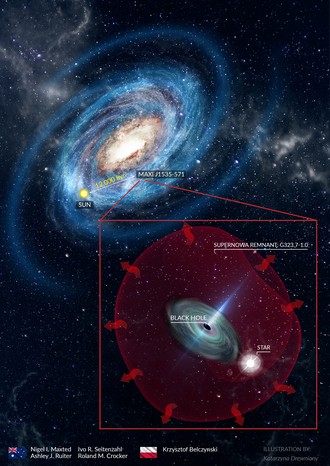
Supernovae explosions are among the most energetic events on the sky. Thermonuclear supernovae are predicted to totally disrupt exploding objects (white dwarfs: supernovae Ia, very massive stars: pair-instability supernovae), while core collapse supernovae mark end of nuclear fusion in stars and are believed to form neutron stars and black holes (supernovae Ib/c, II).
Some of supernovae remnants (expanding shells) were connected with nearby neutron stars, thus confirming stellar evolution predictions. However, until now not a single supernova was convincingly connected with black hole formation.
Australian-Polish team, including Krzysztof Belczyński from CAMK, makes such a connection for a distant (12,000 light years away from Earth) supernova remnant called G323.7-1.0. It appears that within this supernova remnant there is a binary system of two objects known as MAXI J1535-571: unseen small star (maybe twice as massive as our Sun) and a medium size black hole (about 5 times more massive than Sun). The unseen star feeds black hole with matter (most likely by Roche lobe overflow) and as this matter spirals into the black hole it radiates in X-rays that are detected by some of space observatories. Since the black hole is almost right in the center of expanding supernova remnant, and it is at the same distance as supernova remnant, it must be that the supernova has created this black hole in the last 10-20 thousand of years (typical lifetime of supernova remnant). The team estimated that probability of finding a black hole by chance in the position of this supernova is less than 1 in 1000.
Link to original paper: "A supernova remnant associated with a nascent black hole low-mass X-ray binary"
Figure caption:
Milky Way galaxy with marked position of an old supernova remnant (from 10-20 thousands years ago) relative to our Sun. In the expanding supernova remnant (G323.7-1.0) a binary system (MAXI J1535-571) hosting a small star and a medium size black hole is found. It appears that this is the first supernova known to have formed a black hole.






